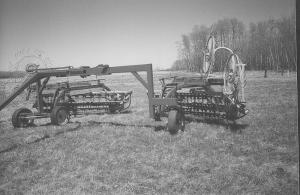Hitch Makes Double Rakes Easy To Handle
 ✖  |
Pull a pin and pull away is all Harold Gleason has to do to trail his left and right hand basket rakes down the road. No hydraulics, no unhooking and no hassle needed. When he gets to the next field, changing to field mode is just as easy.
"All I do is pull the pin keeping the rakes in trail mode, turn left or right and pull into the field," says Gleason. "Once it's back in field travel mode, I replace the pin and start raking."
Gleason and his son have used the rake hitch for at least 10 years. He says he has seen nothing like it on the market.
The simple hitch consists of a single wheel mounted on a dolly at one 4 by 4-in. leg of a 10-ft. long, 4 by 5-in. rectangular steel tube beam with a double wheel dolly at the other end. A rake is hooked to the bar at each dolly. In field mode, the beam runs perpendicular to the direction of travel, with the tow bar mounted mid way on the beam and locked in place. A tie rod connects the tow bar to the twin wheeled dolly, causing those wheels and the hitch to follow when the tractor changes direction.
Unlocking the tow bar and driving ahead causes the rake hitch beam to pivot, pulling the single wheel dolly ahead. Its trailing rake pulls forward and under the 5 1/2 ûft. high beam. The twin wheel dolly and its rake pivot into line directly behind the first rake, with the double wheel dolly adding stability to the in-line rake hitch.
The single wheel came off an old Versatile swather, while the double wheel dolly is made from the rear wheels of an old MF 92 combine. "It probably cost $500 or less with what I had laying around," says Gleason.
Contact: FARM SHOW Followup, Harold Gleason, 2843 Gleason Dr., Tolna, N. Dak. 58380 (ph 701 262-4584).

Click here to download page story appeared in.
Click here to read entire issue
Hitch Makes Double Rakes Easy To Handle HITCHES Hitches 33-3-33 Pull a pin and pull away is all Harold Gleason has to do to trail his left and right hand basket rakes down the road. No hydraulics, no unhooking and no hassle needed. When he gets to the next field, changing to field mode is just as easy.
"All I do is pull the pin keeping the rakes in trail mode, turn left or right and pull into the field," says Gleason. "Once it's back in field travel mode, I replace the pin and start raking."
Gleason and his son have used the rake hitch for at least 10 years. He says he has seen nothing like it on the market.
The simple hitch consists of a single wheel mounted on a dolly at one 4 by 4-in. leg of a 10-ft. long, 4 by 5-in. rectangular steel tube beam with a double wheel dolly at the other end. A rake is hooked to the bar at each dolly. In field mode, the beam runs perpendicular to the direction of travel, with the tow bar mounted mid way on the beam and locked in place. A tie rod connects the tow bar to the twin wheeled dolly, causing those wheels and the hitch to follow when the tractor changes direction.
Unlocking the tow bar and driving ahead causes the rake hitch beam to pivot, pulling the single wheel dolly ahead. Its trailing rake pulls forward and under the 5 1/2 ûft. high beam. The twin wheel dolly and its rake pivot into line directly behind the first rake, with the double wheel dolly adding stability to the in-line rake hitch.
The single wheel came off an old Versatile swather, while the double wheel dolly is made from the rear wheels of an old MF 92 combine. "It probably cost $500 or less with what I had laying around," says Gleason.
Contact: FARM SHOW Followup, Harold Gleason, 2843 Gleason Dr., Tolna, N. Dak. 58380 (ph 701 262-4584).
To read the rest of this story, download this issue below or click
here to register with your account number.







